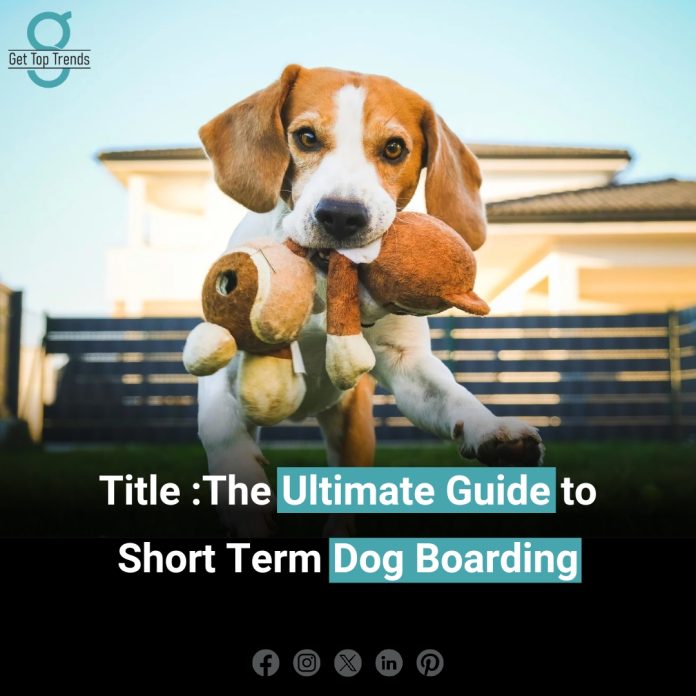Short-term dog boarding can be of great help for owners. It serves well if you need to leave your pet somewhere safe when you can’t be around. Perhaps you have a brief trip, a family get-together or an unexpected matter to handle. Learning how to select a fitting boarding facility and prep your dog for such a setup can give comfort. It’ll be not just for you but also for your fur buddy.
Understanding Short Term Dog Boarding
What is Short Term Dog Boarding?
A service described as “short-term dog boarding” involves keeping dogs in a facility for a limited amount of time, usually one or two days to a few weeks. These facilities offer sustenance, exercise, and supervision in an atmosphere of safety.
Types of Boarding Facilities
Traditional Kennels: Dog facilities commonly offer separate kennels for each pups. They look after the pet’s essential needs like food, activity, and occasionally, grooming.
Dog Hotels/Luxury Boarding: They provide high-end places to stay. These places include extras like soft beds, particular TVs for dogs, and time set aside for play tailored to your pet.
In-Home Boarding: Certain providers open their homes for boarding. They add a unique personal touch, creating a comfy, home-like feeling for the dog..
Veterinary Boarding: For dogs with particular requirements, boarding services are often provided by veterinary clinics.
Choosing the Right Facility
Factors to Consider
Reputation and Reviews: Check out the place’s reputation. Search for internet feedback, requestst suggestions from pals or your animal doctor, and visit the place if you can.
Cleanliness and Safety: The place must be tidy, properly upkeep, and safe. This means having things like strong fences and supervised entry.
Staff Qualifications: Make sure the team knows about taking care of pets. They should be ready for medical emergencies and know how dogs behave.
Facilities and Amenities: Examine the living arrangements, the play areas, and the availability of extra services, such as training or grooming.
Vaccination Requirements: Verification of current vaccination histories is necessary for reputable boarding houses in order to stop the spread of illness.
Preparing Your Dog for Boarding
Health Check
Vaccinations: Make sure your dog has received all of the recommended vaccinations, such as rabies, DHPP (distemper, hepatitis, parainfluenza, and parvovirus), and bordetella (kennel cough).
Flea and Tick Prevention: Administer flea and tick prevention before boarding.
Medications: Prepare a list of any medications your dog needs, with clear instructions.
Packing Essentials
To avoid nutritional problems, bring enough of your dog’s usual food for your visit.Bring a favourite blanket, toy, or anything that smells like you to provide comfort.Ensure your dog is wearing a collar that fits properly and has tags for identification.
Pre-Boarding Visit
Try bringing your pup to the facility prior. This can familiarize them with the new setting and lessen their worry while they’re there.
During the Boarding Period
Communication
Getting Updates: Check with the place if they offer news or snapshots while your dog’s there.
Emergency number : Supply a dependable contact number, and be sure someone’s on hand to be the decider if they can’t reach you.
Monitoring Your Dog
Behaviour: Note that some dogs may feel anxious and act a bit different once they’re back home. This should be temporary.
Health: Keep a close eye on your dog for any odd health signs or weird actions after their stay at the kennel and check in with your vet if you need to.
Conclusion
Dog boarding for a short time is excellent. It helps your dog stay protected, pampered and cheerful when you’re off. Selecting a suitable place, readying your pup correctly, and staying connected are vital. These steps help make the experience good for you and your tail-wagger. This guide will help. It ensures you make stellar choices for your dog’s brief boarding needs. It keeps them well and gives you calmness.
Frequently Asked Questions
1. What is the difference between traditional kennels and dog hotels?
Traditional kennels usually offer simple services for dogs. Each pet has its kennel, gets food routinely, a good exercise, and sometimes a grooming session. Quite differently, dog hotels or high-end boarding places provide nicer benefits.
2. How can I ensure the boarding facility is safe and suitable for my dog?
When picking a boarding place for your pet, doing some homework is essential. Reviews online can offer insights. Your friends or vet might also suggest good ones. Seeing the place firsthand can be beneficial. Can you spot a tidy environment? Well-maintained? Safety measures like sturdy fences and monitored entry are good signs. The staff should also be familiar with pets and know what to do in emergencies.
3. What should I pack for my dog’s stay at a boarding facility?
Remember, pack your dog’s regular food to prevent tummy troubles. Toss in a cherished blanket, a beloved toy, or something that has your scent for their peace of mind. Make sure your dog’s collar fits just right and has ID tags. Don’t forget to make a list of the meds your dog takes. Provide clear dosing instructions for the workers, too.
4. How can I prepare my dog for their first boarding experience?
Are you getting your pup ready for their first stay at a boarding facility? Here’s your checklist. Teddy needs his vaccinations current, which include rabies, DHPP, and bordetella. Don’t forget the flea and tick prevention before boarding. Take him for a friendly visit to the boarding place beforehand. This trip will help Teddy get to know the fresh surroundings and feel less nervous. When it’s time for the stay, leave a dependable phone number.




